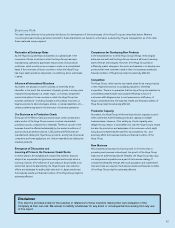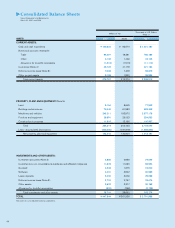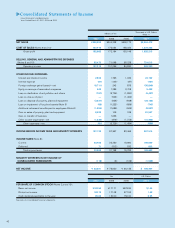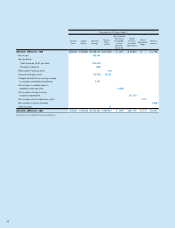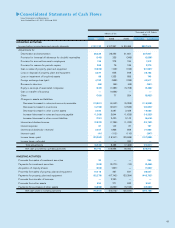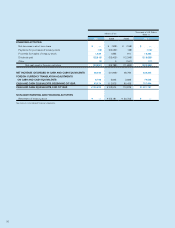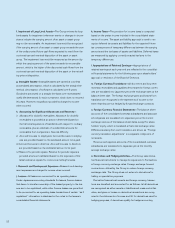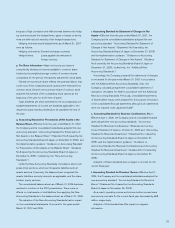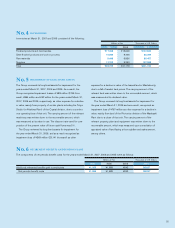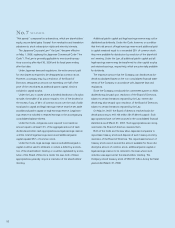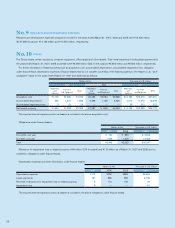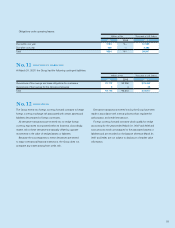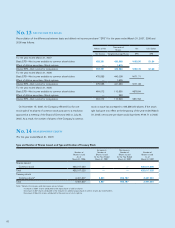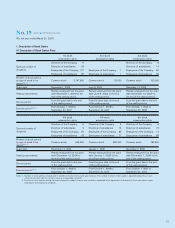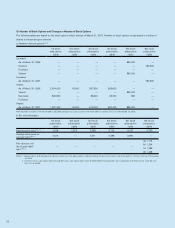Pentax 2007 Annual Report Download - page 54
Download and view the complete annual report
Please find page 54 of the 2007 Pentax annual report below. You can navigate through the pages in the report by either clicking on the pages listed below, or by using the keyword search tool below to find specific information within the annual report.
52
f. Impairment of Long-Lived Assets—The Group reviews its long-
lived assets for impairment whenever events or changes in circum-
stance indicate the carrying amount of an asset or asset group
may not be recoverable. An impairment loss would be recognized
if the carrying amount of an asset or asset group exceeds the sum
of the undiscounted future cash flows expected to result from the
continued use and eventual disposition of the asset or asset
group. The impairment loss would be measured as the amount by
which the carrying amount of the asset exceeds its recoverable
amount, which is the higher of the discounted cash flows from the
continued use and eventual disposition of the asset or the net sell-
ing price at disposition.
g. Intangible Assets—Intangible assets are carried at cost less
accumulated amortization, which is calculated by the straight-line
method. Amortization of software is calculated over 5 years.
Goodwill is amortized on a straight-line basis over its estimated
useful life determined for each investment, which does not exceed
20 years. However, insignificant goodwill is charged to income
when incurred.
h. Accounting for Significant Allowances and Reserves—
i) Allowance for doubtful receivables: Allowance for doubtful
receivables is provided at an amount determined based on
the historical experience of bad debts with respect to ordinary
receivables, plus an estimate of uncollectible amounts for
receivables from companies in financial difficulty.
ii) Accrued bonuses to employees: Accrued bonuses to employ-
ees are provided based on the estimated amount to be paid.
iii) Accrued bonuses to directors: Accrued bonuses to directors
are provided based on the estimated amount to be paid.
iv) Reserve for periodic repairs: Reserve for periodic repairs is
provided at amount estimated based on the expenses of the
latest extensive repairs for continuous melting furnaces.
i. Research and Development Expenses—Research and develop-
ment expenses are charged to income when incurred.
j. Leases—All leases are accounted for as operating leases.
Under Japanese accounting standards for leases, finance leases
that deem to transfer ownership of the leased property to the les-
see are to be capitalized, while other finance leases are permitted
to be accounted for as operating lease transactions if certain “as if
capitalized” information is disclosed in the notes to the lessee’s
consolidated financial statements.
k. Income Taxes—The provision for income taxes is computed
based on the pretax income included in the consolidated state-
ments of income. The asset and liability approach is used to rec-
ognize deferred tax assets and liabilities for the expected future
tax consequences of temporary differences between the carrying
amounts and the tax bases of assets and liabilities. Deferred taxes
are measured by applying currently enacted tax laws to the
temporary differences.
l. Appropriations of Retained Earnings—Appropriations of
retained earnings at each year end are reflected in the consolidat-
ed financial statements for the following year upon shareholders’
approval or resolution of the Board of Directors.
m. Foreign Currency Translations—All short-term and long-term
monetary receivables and payables denominated in foreign curren-
cies are translated into Japanese yen at the exchange rates at the
balance sheet date. The foreign exchange gains and losses from
translation are recognized in the statements of income to the
extent that they are not hedged by forward exchange contracts.
n. Foreign Currency Financial Statements—The balance sheet
accounts of the consolidated overseas subsidiaries and associat-
ed companies are translated into Japanese yen at the current
exchange rates as of the balance sheet dates except for share-
holders’ equity, which is translated at historical exchange rates.
Differences arising from such translation are shown as “Foreign
currency translation adjustments” in a separate component of
net assets.
Revenue and expense accounts of the consolidated overseas
subsidiaries are translated into Japanese yen at the monthly
average exchange rates.
o. Derivatives and Hedging Activities—The Group uses deriva-
tive financial instruments to manage its exposures to fluctuations
in foreign currency exchange rates. Foreign exchange forward
contracts are utilized by the Group to reduce foreign currency
exchange risks. The Group does not enter into derivatives for
trading or speculative purposes.
Derivative financial instruments and foreign currency transac-
tions are classified and accounted for as follows: (a) all derivatives
are recognized as either assets or liabilities and measured at fair
value, and gains or losses on derivative transactions are recog-
nized in the statements of income and (b) for derivatives used for
hedging purposes, if derivatives qualify for hedge accounting



